
Bill Widmer is a content marketing and SEO consultant specializing in e-commerce.
There’s no doubt about it…
Search Engine Optimization (SEO) is one of the most powerful ways to increase your store’s traffic, brand awareness, and revenue.
But building links to product or category pages is really hard. No one likes to send their visitors to buy someone else’s product unless it’s truly amazing (or they’re making a commission).
That’s where content comes in. Creating link-worthy blog articles is the fastest way to rank your product pages, grow your site’s organic traffic, and grow your bottom line.
In this post, I’m going to share my step-by-step SEO content strategy so you can get started ranking your product pages.
The Power of SEO (And Why You Want to Rank Your Product Pages)
First of all, why should you care about ranking your product pages? I mean, it’s a lot of work—is eCommerce SEO really worth it?
The answer is a resounding yes. Here’s why:
Let’s say you sell Apple Cider Vinegar Face Wash. When we look that up with Google’s Keyword Planner, we can see it gets 1,000 to 10,000 searches per month.
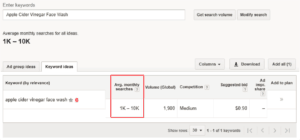
So on an average month, let’s say it gets 5,000 searches per month. Roughly 33% of all traffic on a search engine results page (SERP) goes to the first result (50% or more if it’s a featured snippet).
That translates to 1,650 visits per month. At a 3% conversion rate, that’s an extra 49.5 sales per month. And that’s not even including the other keywords you might rank for!
As a bonus, you can even remarket to the people who don’t convert to scoop up some extra sales. (Just set up your Facebook pixel and start firing off some remarketing ads.)
I hope you’re convinced by now. SEO is a powerful investment that can give you returns for years to come…
…but you need backlinks to rank. Which is where content comes in.
How to Rank Your Product Pages With No Backlinks (5 Steps)
Links from other websites to your website (aka backlinks) are one of Google’s top two ranking factors.
In fact, a study done by Brian Dean from Backlinko (alongside SEMRush, Ahrefs, MarketMuse and SimilarWeb) found that the number of domains linking to a page correlated with rankings more than any other factor.
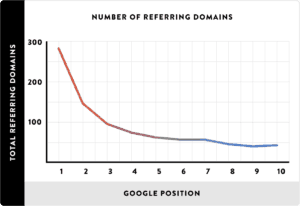
In other words, if you want your product pages to rank, you need more websites linking to you.
But here’s the caveat:
Internal links from a page with a lot of backlinks can pass page authority to the page you’re linking to!
In other words, if you have some epic blog content with a lot of backlinks, and link from that blog post to your product page, your product page will rank higher. Here’s a visual:
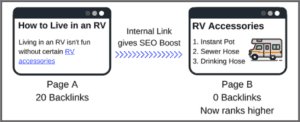
This means that your blog is one of your most powerful tools for building links to your website, increasing your Domain Authority (DA), and ranking your product pages.
So how’s it done?
As I lay out in my white hat SEO case study, there are five main steps to a successful content link building campaign:
Step 1: Create a list of influencers
Influencers, in this case, means anyone with a medium-large following and a website with a high DA. (You can see a website’s DA for free with the MozBar browser extension.)
You want a list of influencers for three reasons:
- To help you find a good blog topic,
- To help you promote your content when it goes live,
- And to get links to your content.
Finding them is easy enough – just Google things you might write about. For example, if I was selling that Apple Cider Vinegar Face Wash, I might Google things like “beauty routine”, “skincare tips”, “beauty bloggers”, etc.
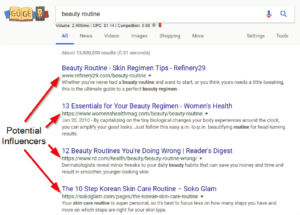
But if you need something even easier, try searching this influencer database. It’s full of people who have a following and want to partner with sites like yours.
Once you have a list of at least 15-30 people, it’s time for step 2.
Step 2: Choose a great topic
Influencers are influencers because they talk about the things people in their industry care about. That’s why people follow them, after all!
So the easiest way to come up with a great topic? Go to the influencers’ websites and see what they’re already talking about.
For example, Women’s Health is talking about “Old Wives Healing Remedies”. Topic idea.

Refinery 21 is talking about night-time skincare routines, The Klog is just wrote about the biggest skincare mistake you can make, and Elle published an article on oily skin. All topic ideas that are likely to do well!
The thing to look for more than anything, though, is this: Similar topics across multiple influencer’s website. In this case, the big thing is skincare routines.
Once you’ve chosen a proven topic, it’s time to research your primary keyword.
Step 3: Research your keyword
Finding a good keyword to target on your blog post is easier than it might sound. All you need is a tool (like Google Keyword Planner or Ahrefs) and a vague topic idea.
Go to your keyword research tool and search for a broad term around your topic idea. In this case, I’ll start with “skincare routine”.
We’re looking for medium-tail keywords (generally 2-4 words long) with decent search volume.
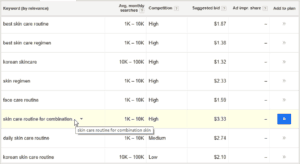
The key phrase “skin care routine for combination skin” really sticks out to me here. Not only does it get a lot of search traffic, but it also has a very high cost-per-click (CPC). A high CPC generally translates to a high conversion rate, because people are willing to spend money on it.
Note: The “competition” column here doesn’t mean search ranking competition, it refers to advertising competition. So don’t worry about it too much.
Once you’ve chosen a keyword, it’s time to get those fingers to typing!
Step 4: Create epic content
“Epic content” just means something really valuable to your reader. It’s well-written, actionable, and looks great.
Typically, you want to write content that’s at least 2,000 words long. This is because long-form content tends to rank higher on Google.
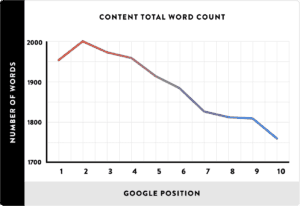
If you’re not a great writer or feel intimidated by that, you can always hire a writer on UpWork or People Per Hour.
But if you’re feeling up to writing it yourself, check out this guide to writing epic content.
Now here’s where most people stop. But you still have one more crucial step once you publish your new post!
Step 5: Promote and build links
Just sharing your new blog post on social media and crossing your fingers won’t cut it. You need to promote your content heavily to earn those visitors and links.
Here are some things you can do right now:
- Send the article to anyone you mentioned or linked to (it’s a good idea to include those influencers you found in your post for this reason).
- Post your article to Quuu Promote.
- Share it on any relevant Facebook groups.
- Join Pinterest group boards and pin it there.
After you’ve promoted the content, the next step is link building. I highly recommend Brian Dean’s link building guide.
One Last Step: Internal links
I know I said five steps, but there’s one last quick thing you need to do.
Once you have some links pointing to your new blog post, add an internal link from that post to the product or category page you want to rank higher. Use exact-match anchor text.
So if you want to rank for “Apple Cider Vinegar Face Wash”, link those exact words to your product page. Simple, right?
Pro Tip: Make ranking even easier by improving your product page design to be optimized for both SEO and conversions.
Conclusion
While eCommerce SEO is simple and highly effective, it isn’t easy. So anything you can do to make ranking your product pages easier is a must.
Because high-quality content attracts links, you should leverage your blog to increase your site’s overall DA. Then Google will send you consistent, high-quality traffic. Better yet – these people are already ready to buy.
Bill Widmer is a content marketing and SEO consultant specializing in e-commerce.
Favorite